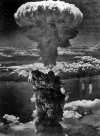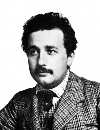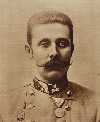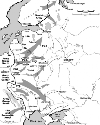 The Treaty on the Non-Proliferation of Nuclear Weapons is an international agreement to limit the spread of nuclear weapons. It was originally signed by the US, Britain, the USSR, and 59 other countries in 1968. The major signatories agreed not to help nonnuclear states obtain or produce nuclear weapons, while the nonnuclear signatories agreed not to try to obtain them. The treaty was extended indefinitely in 1995, and nearly 190 countries are now party to it. Which nations have never signed it? Discuss
The Treaty on the Non-Proliferation of Nuclear Weapons is an international agreement to limit the spread of nuclear weapons. It was originally signed by the US, Britain, the USSR, and 59 other countries in 1968. The major signatories agreed not to help nonnuclear states obtain or produce nuclear weapons, while the nonnuclear signatories agreed not to try to obtain them. The treaty was extended indefinitely in 1995, and nearly 190 countries are now party to it. Which nations have never signed it? Discuss
Source: The Free Dictionary
 In physics, the theory of special relativity generalizes Galileo’s principle of relativity—that all uniform motion is relative and that there is no absolute state of rest. Though physicists Hendrik Lorentz and Henri Poincaré had made contributions to the theory already, Einstein provided a radically new interpretation in his 1905 paper “On the Electrodynamics of Moving Bodies.” In it, Einstein redefines the concepts of space and time and abolishes the concept of “aether,” which is what?
In physics, the theory of special relativity generalizes Galileo’s principle of relativity—that all uniform motion is relative and that there is no absolute state of rest. Though physicists Hendrik Lorentz and Henri Poincaré had made contributions to the theory already, Einstein provided a radically new interpretation in his 1905 paper “On the Electrodynamics of Moving Bodies.” In it, Einstein redefines the concepts of space and time and abolishes the concept of “aether,” which is what?  The first in a series of seven docking missions the US Space Shuttle Atlantis flew to the Russian space station Mir, the STS-71 mission was a notable episode in spaceflight history, as it marked the 100th manned space launch by the US and the first ever on-orbit crew change. The five-day docking of the two crafts also marked the creation of the largest spacecraft ever placed into orbit at that time. When linked, Atlantis and Mir had a total mass of how many tonnes?
The first in a series of seven docking missions the US Space Shuttle Atlantis flew to the Russian space station Mir, the STS-71 mission was a notable episode in spaceflight history, as it marked the 100th manned space launch by the US and the first ever on-orbit crew change. The five-day docking of the two crafts also marked the creation of the largest spacecraft ever placed into orbit at that time. When linked, Atlantis and Mir had a total mass of how many tonnes?  Nephew of Francis Joseph, emperor of Austria and king of Hungary, Ferdinand became heir apparent in 1896. While visiting Sarajevo, he and his wife were assassinated by Serbian nationalist Gavrilo Princip. Austria soon declared war on Serbia, prompting countries allied with Austria-Hungary—the Central Powers—and those allied with Serbia—the Triple Entente—to declare war on each other, precipitating WWI. The assassination was not the first attempt on his life. What had happened earlier that day?
Nephew of Francis Joseph, emperor of Austria and king of Hungary, Ferdinand became heir apparent in 1896. While visiting Sarajevo, he and his wife were assassinated by Serbian nationalist Gavrilo Princip. Austria soon declared war on Serbia, prompting countries allied with Austria-Hungary—the Central Powers—and those allied with Serbia—the Triple Entente—to declare war on each other, precipitating WWI. The assassination was not the first attempt on his life. What had happened earlier that day?  Smith was the founder of the Church of Jesus Christ of the Latter-day Saints. He established his first church in New York but was forced to move his headquarters to Ohio, Missouri, and then Illinois. In 1844, he announced his candidacy for the presidency of the US, but he was imprisoned for treason after his efforts to silence Mormon dissenters led to mob violence. While in jail, Smith and his brother were murdered by a mob. Who led the Mormons to Utah after his death?
Smith was the founder of the Church of Jesus Christ of the Latter-day Saints. He established his first church in New York but was forced to move his headquarters to Ohio, Missouri, and then Illinois. In 1844, he announced his candidacy for the presidency of the US, but he was imprisoned for treason after his efforts to silence Mormon dissenters led to mob violence. While in jail, Smith and his brother were murdered by a mob. Who led the Mormons to Utah after his death?  According to a centuries-old legend set in Hamelin, Germany, the Pied Piper was hired by local residents in 1284 to rid the town of rats, which he did by charming them with music and leading them to the river to drown. When the citizens refused to pay him the agreed upon price, he exacted his revenge by charming away their children. Famous versions of the legend were immortalized by Goethe, Robert Browning, and the Brothers Grimm. What historic events may have inspired the tale?
According to a centuries-old legend set in Hamelin, Germany, the Pied Piper was hired by local residents in 1284 to rid the town of rats, which he did by charming them with music and leading them to the river to drown. When the citizens refused to pay him the agreed upon price, he exacted his revenge by charming away their children. Famous versions of the legend were immortalized by Goethe, Robert Browning, and the Brothers Grimm. What historic events may have inspired the tale?  Popularly known as “Custer’s Last Stand,” the Battle of the Little Bighorn occurred during the US government’s campaign to force the Cheyenne and Sioux onto reservations using federal troops. Upon encountering a large encampment of the tribes, General George Custer launched an early attack with a party of approximately 200 soldiers. The troops were annihilated by the vastly larger force, and Custer himself was killed during the battle along with two of his brothers. Who led the Indian alliance?
Popularly known as “Custer’s Last Stand,” the Battle of the Little Bighorn occurred during the US government’s campaign to force the Cheyenne and Sioux onto reservations using federal troops. Upon encountering a large encampment of the tribes, General George Custer launched an early attack with a party of approximately 200 soldiers. The troops were annihilated by the vastly larger force, and Custer himself was killed during the battle along with two of his brothers. Who led the Indian alliance?  In 1995, the recently unified nation of South Africa hosted the third Rugby World Cup. The first major event to be held in what had been dubbed “the Rainbow Nation,” it is now remembered as one of the greatest moments in the country’s sporting history. The dramatic victory of the South African team, supported by President Nelson Mandela, is seen as a major step in the reconciliation of white and black South Africans in the post-Apartheid era. What team did South Africa defeat in the final match?
In 1995, the recently unified nation of South Africa hosted the third Rugby World Cup. The first major event to be held in what had been dubbed “the Rainbow Nation,” it is now remembered as one of the greatest moments in the country’s sporting history. The dramatic victory of the South African team, supported by President Nelson Mandela, is seen as a major step in the reconciliation of white and black South Africans in the post-Apartheid era. What team did South Africa defeat in the final match?  As a teen, American inventor Christopher Latham Sholes apprenticed with a printer and later became a newspaper publisher. In 1868, he, Carlos Glidden, and Samuel W. Soulé were granted a patent for their design for the first practical typewriter. Five years later, he sold his rights for $12,000 to the Remington Arms Co., which developed the Remington Typewriter. Sholes went on to invent the so-called QWERTY keyboard that is still in use today. Why did he arrange the letters in this unusual order?
As a teen, American inventor Christopher Latham Sholes apprenticed with a printer and later became a newspaper publisher. In 1868, he, Carlos Glidden, and Samuel W. Soulé were granted a patent for their design for the first practical typewriter. Five years later, he sold his rights for $12,000 to the Remington Arms Co., which developed the Remington Typewriter. Sholes went on to invent the so-called QWERTY keyboard that is still in use today. Why did he arrange the letters in this unusual order?  The largest military operation of World War II, Operation Barbarossa was the codename for Nazi Germany’s invasion of the Soviet Union. Named for 12th-century crusader and Holy Roman Emperor Frederick Barbarossa, the Axis operation included more than 4.5 million troops over a 1,800-mile (2,900-km) front. Though the Red Army suffered heavy losses, Operation Barbarossa failed and marked a turning point in the war that many believe sealed the Nazis’ fate. How many were killed during the operation?
The largest military operation of World War II, Operation Barbarossa was the codename for Nazi Germany’s invasion of the Soviet Union. Named for 12th-century crusader and Holy Roman Emperor Frederick Barbarossa, the Axis operation included more than 4.5 million troops over a 1,800-mile (2,900-km) front. Though the Red Army suffered heavy losses, Operation Barbarossa failed and marked a turning point in the war that many believe sealed the Nazis’ fate. How many were killed during the operation?